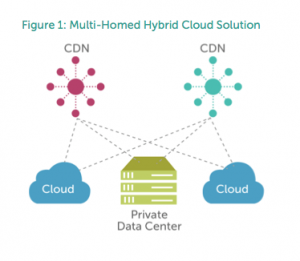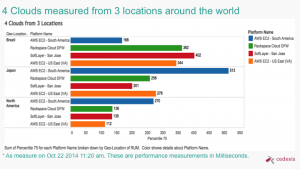- Call: 0203 427 3507
- Email: innovation@clustre.net
The cloud is virtually everywhere
The majority of businesses are now using the services of cloud providers and/or CDNs. A recent survey by RightScale revealed that 93% of respondents are now using the cloud with 58% operating a hybrid model (see diagram below).

The same RightScale report also shows that 82% of organisations with over 1000 employees have a multi-cloud strategy.
Similarly, businesses that operate 24×7 globally-accessible websites are increasingly using CDNs (cloud providers in essence) to give their users fast, low-cost, uninterrupted content.
No longer are we querying whether to use cloud services. The questions now are which service providers and CDNs to use and how to make the most cost-effective use of them.
But is this picture just too perfect to be true? Does the promise of uninterrupted, responsive, hassle-free

cloud services really stack up? That’s the question I want to ask and the answers are both revealing and worrying…
Performance varies by geography and vendor
Just because you have signed up with multi-cloud and/or CDN providers doesn’t mean that your problems are instantly solved. Far from it. Different providers deliver very different levels of performance. And this wildly fluctuating performance is largely dictated by geography. Where vendors can afford to be sited close to their clients, the service is often consistently good. But when funding pressures stretch that link, the results can be seriously alarming…
This diagram shows the cloud performance experienced by users in three different geographies – Brazil, Japan and North America. Four clouds in three locations – and the stats speak for themselves. The performance varies by a factor of 2 (or more) and the drop-off is almost entirely triggered by geography…
 Availability is also far from guaranteed
Availability is also far from guaranteed
And the problem isn’t confined to just drop-off. There’s only one thing worse than a poorly performing application… one that’s not even functioning. Despite the reality of Active-Active DR there is still an unacceptable level of total outages. And believe me, no-one is infallible. Even the mighty AWS (with four times more business than any other cloud provider) recently managed to take down Vine and Instagram for over an hour!
And paying top dollar can be an expensive mistake
One of the key reasons enterprises use multiple vendors (apart from ensuring availability) is to avoid vendor lock-in. Negotiations can get ugly when your vendor knows you have no viable choice. But then again, how can you be certain you’re buying the best and most cost-effective service at any one time?
The simple truth is that few – very few – users need the fastest service all the time. That is an extremely high-speed, high-cost strategy. Equally, companies need to avoid excessive penalties for exceeding usage agreements. Frustratingly, a high proportion of these penalty charges are unnecessary since users are often well under the threshold with other vendors. That is a very costly own-goal!
Now let’s play a game of ‘What if?’
Just imagine that you could automatically – and in real time – move users between cloud service providers, private clouds and CDNs. Imagine that you were totally free to optimise performance, availability and cost. Now suspend imagination and think reality…
In summary…
Hybrid Cloud orchestration has arrived. It provides active management of a cloud-aware application across multiple content and hosting environments – including combinations of public and private resources.
Unlike their traditional counterparts, cloud-aware applications can be optimised – in real time – to adapt to changes in usage, traffic and resource contention. What’s more, these application architectures are miraculously self-healing. They self-correct around network, bare-metal server, cloud and platform outages.
Mind you, self-healing calls for traffic shaping across clouds, content delivery networks (CDNs) and private data centres. It’s not a trivial task. And there’s no denying, this can be tricky. However, the pay-back in terms of robust applications with incredible fault-tolerance and extremely low time between failures is enormous. What price would you pay for virtual fail-safe security?
Automated, real-time decisions need to be made with data representing the holistic health of your complete cloud and data centre infrastructure. If done well, these architectural elements can also perform the dual purpose of making an application perform at its optimum performance potential.
No-one can guarantee it will never rain – but at least you can now be certain it will never be more than a momentary shower.